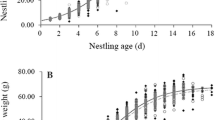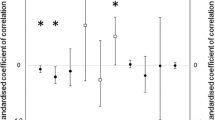Summary
The sex ratios of nestling Falconiformes in which males are smaller than females are often female biased, despite the apparent costs involved in producing very large female offspring. In Australian peregrine falcons, Falco peregrinus, this bias is most pronounced in broods produced early in the season, and the first eggs to be laid are most likely to produce females. Females that lay early are most likely to be successful breeders. Very large chicks tend to occur in female-biased broods. Collectively, these data suggest that females likely to produce large offspring produce daughters. A modified version of the Trivers/Willard hypothesis is suggested to account for this pattern.
Similar content being viewed by others
References
Aumann T (1986) Aspects of the biology of the brown goshawk Accipiter fascia tus fasciatus in southeastern Australia. MS thesis. Monash University, Melbourne
Balfour E, Cadbury JC (1979) Polygyny, spacing and sex ratio among hen harriers Circus cyaneus (L.) in Orkney, Scotland. Ornis Scand 30:6–12
Balgooyen TG (1976) Behaviour and ecology of the American kestrel (Falco sparverius L.). Univ Calif Publ Zool 103:1–85
Beebe FL (1960) The marine peregrines of the northwest Pacific coast. Condor 62:145–189
Bortolotti GR (1986a) Factors influencing the growth of bald eagles in north central Saskatchewan. Can J Zool 67:601–611
Bortolotti GR (1986b) Influence of sibling competition on nestling sex ratios of sexually dimorphic birds. Am Nat 127:495–507
Breitwisch R (1989) Mortality patterns, sex ratios, and parental investment in monogamous birds. Curr Ornithol 6:1–50
Burley N (1981) Sex ratio manipulation and selection for attractiveness. Science 211:721–722
Burley N (1986a) Sex ratio manipulation in colour-banded populations of zebra finches. Evolution 40:1191–1206
Burley N (1986b) Sexual selection for aesthetic traits in species with biparental care. Am Nat 127:415–445
Charnov EL (1982) The theory of sex allocation. Princeton University Press, Princeton
Clark AB (1978) Sex ratio and local resource competition in a prosimian primate. Science 201:163–165
Clutton-Brock TH (1986) Sex ratio variation in birds. Ibis 128:317–329
Clutton-Brock TH, Albon SD, Guinness FE (1985) Parental investment and sex differences in juvenile mortality in birds and mammals. Nature 313:131–133
Court GS (1986) Some aspects of the reproductive biology of tundra peregrine falcons. MS thesis. University of Alberta, Edmonton
Enderson JH (1964) A study of the prairie falcon in the central Rocky mountain region. Auk 81:332–352
Fisher RA (1930) The genetical theory of natural selection. Clarendon Press, Oxford
Fiuczynski D (1978) Zur Populationsokölogie des Baumfalken (Falco subbuteo L. 1758) Zool Jahrb Syst 105:193–257
Frank SA (1987) Individual and population sex allocation patterns. Theor Popul Biol 31:47–74
Godfray HCJ (1986) Models for clutch size and sex ratio with sibling interactions. Theor Popul Biol 30:215–231
Godfray HCJ, Harvey PH (1986) Bald eagle sex ratios: ladies come first. Trends Ecol Evol 1:56–57
Heintzelman DS, Nagy AC (1968) Clutch size, hatchability rates, and sex ratios of sparrow hawks in eastern Pennsylvania. Wilson bull 80:306–311
Hickey JJ (1942) Eastern populations of the duck hawk. Auk 59:176–204
Johnson CN (1988) Dispersal and the sex ratio at birth in primates. Nature 332:726–728
Kumar TS (1985) The life history of the spotted owlet (Athene brama brama, Temminck) in Andhra Pradesh. Raptor Research Centre, Hyderabad
Lande R (1987) Genetic correlations between the sexes in the evolution of sexual dimorphism and mating preferences. In: Bradbury JW, Andersson MB (eds) Sexual selection: testing the alternatives. Wiley, Chichester, pp 83–94
MacArthur RH (1965) Ecological consequences of natural selection. In: Waterman TH, Morowitz PH (eds) Theoretical and mathematical biology. Blaisdell, New York, pp 388–397
Mader WJ (1975) Biology of the Harris hawk in southern Arizona. Living Bird 14:59–85
Mattox WG, Seegar WS (1988) The Greenland peregrine falcon survey 1972–1985, with emphasis on recent population studies. In: Cade TJ, Enderson JH, Thelander CG, White CW (eds) Peregrine falcon populations: their management and recovery. The Peregrine Fund, Boise, pp 27–36
Mearns R, Newton I (1984) Turnover and dispersal in a peregrine Falco peregrinus population. Ibis 126: 347–355
Mearns R, Newton I (1988) Factors affecting breeding success of peregrines in south Scotland. J Anim Ecol 57:903–916
Nagy AC (1963) Population density of sparrow hawks in eastern Pennsylvania. Wilson Bull 75:93
Nelson RW (1977) Behavioral ecology of coastal peregrines (Falco peregrinus pealei). PhD thesis, University of Calgary, Alberta
Newton I (1978) Feeding and development of sparrowhawk nestlings. J Zool 184:465–487
Newton I (1979) Population ecology of raptors. Poyser, Calton
Newton I (1986) The sparrowhawk. Poyser, Calton
Newton I (1988x) Individual performance in sparrowhawks: the ecology of the two sexes. Proc Int Ornithol Congress 1:125–154
Newton I (1988b) Age and reproduction in the sparrowhawk. In: Clutton-Brock TH (ed) Reproductive success: studies of individual variation in contrasting breeding systems. University of Chicago Press, Chicago, pp 201–219
Newton I, Marquiss M (1979) Sex ratio among nestlings of the European sparrowhawk. Am Nat 113:309–315
Newton I, Mearns R (1988) Population ecology of peregrines in south Scotland. In: Cade TJ, Enderson JH, Thelander CG, White CW (eds) Peregrine falcon populations: their management and recovery. The Peregrine Fund, Boise, pp 651–666
Newton I, Meek E, Little B (1986) Population and breeding of Northumbrian merlins. Br Birds 79:155–170
Ogden VT (1975) Nesting density and reproductive success of the prairie falcon in southwest Idaho. Raptor Research Report 3:67–69, Raptor Research Foundation, Vermillion
Olsen PD, Olsen J (1987x) Sexual size dimorphism in raptors: intrasexual competition in the larger sex for a scarce breeding resource, the smaller sex. Emu 87:59–62
Olsen PD, Olsen J (1987b) Estimating the age of nestling raptors. Aust Bird Watcher 12:130–131
Olsen PD, Olsen J (1988a) Population trends, distribution and status of the peregrine falcon in Australia. In: Cade TJ, Enderson JH, Thelander CG, White CW (eds) Peregrine falcon populations: their management and recovery. The Peregrine Fund, Boise, pp 255–274
Olsen PD, Olsen J (1988b) Breeding of the peregrine falcon Falco peregrinus. I. Weather, nest spacing and territory occupancy. Emu 88:195–201
Olsen PD, Olsen J (1989x) Breeding of the peregrine falcon Falco peregrinus. II. Weather, nest quality and the timing of egglaying. Emu 89:1–5
Olsen PD, Olsen J (1989b) Breeding of the peregrine falcon Falco peregrinus. III. Weather, nest quality and breeding success. Emu 89:6–14
Picozzi N (1983) Growth and sex of nestling merlins in Orkney. Ibis 125:377–382
Porter RD, Wiemayer SN (1972) Reproductive patterns in American kestrels (sparrowhawks). Condor 74:46–53
Ratcliffe D (1980) The peregrine falcon. Buteo Books, Vermillion
Ricklefs RE (1973) Patterns of growth in birds. II. Growth rate and mode of development. Ibis 115:117–201
Roest AI (1957) Notes on the American sparrow hawk. Auk 74:1–19
Smith DG, Wilson CR, Frost HH (1972) The biology of the American kestrel in central Utah. Southwest Nat 17:73–83
Temeles EJ (1985) Sexual size dimorphism of bird-eating hawks: the effect of prey vulnerability. Am Nat 125:485–499
Trivers RL, Willard DE (1973) Natural selection of parental ability to vary the sex ratio of offspring. Science 191:249–263
Watson D (1977) The hen harrier. Poyser, Berkhamsted
Wiemayer SN (1985) Propagation of captive screech-owls. J Raptor Res 21:49–56
Wikman M (1976) Sex ratio of Finnish nestling goshawks Accipiter gentilis (L.). Congr Int Union Game Biol 12:1–6
Williams GC (1979) The question of adaptive sex ratio in out-crossed vertebrates. Proc R Soc Lond B205:567–580
Author information
Authors and Affiliations
Additional information
Offprint requests to: P.D. Olsen at the second address
Rights and permissions
About this article
Cite this article
Olsent, P.D., Cockburn, A. Female-biased sex allocation in peregrine falcons and other raptors. Behav Ecol Sociobiol 28, 417–423 (1991). https://doi.org/10.1007/BF00164123
Received:
Accepted:
Published:
Issue Date:
DOI: https://doi.org/10.1007/BF00164123




